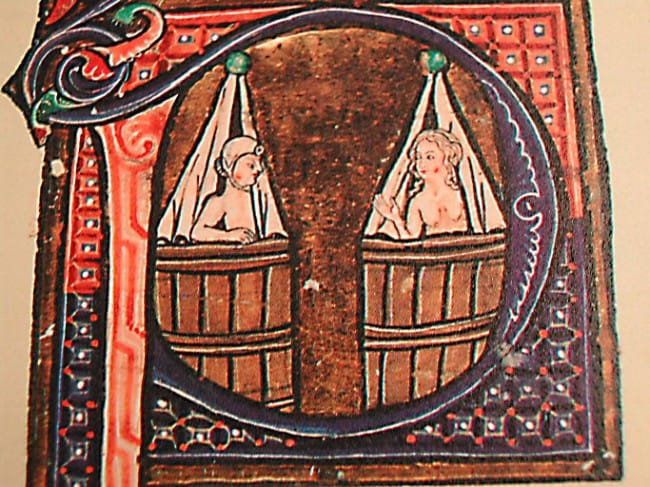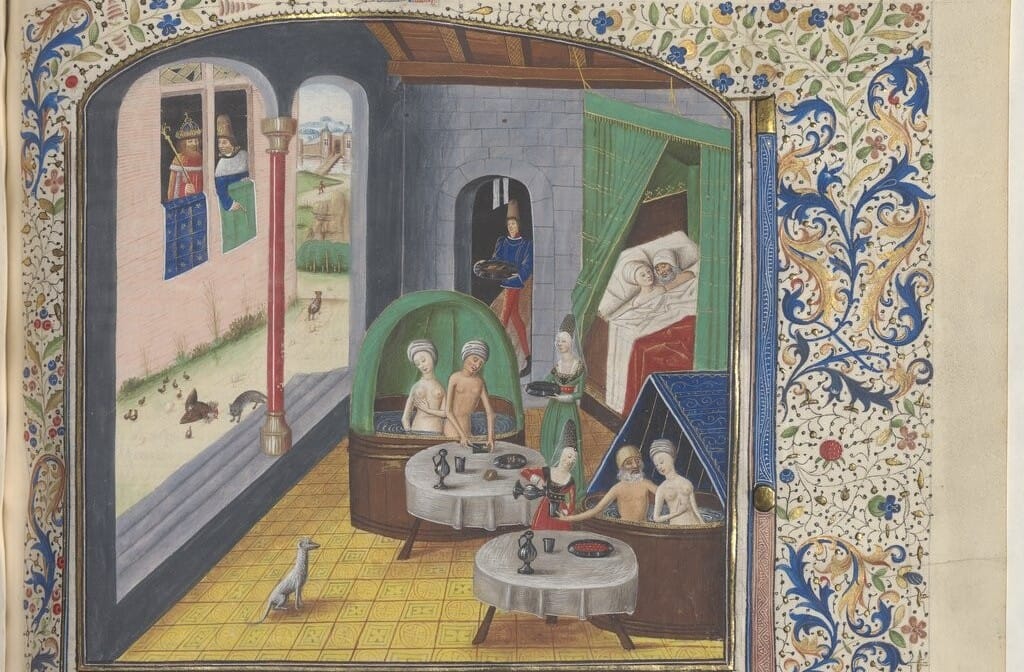There is a persistent stereotype that in the Middle Ages people did not adhere to any rules of hygiene and almost never washed. We decided to check if this is really the case.
Information that medieval people neglected washing can be found in regional And federal Media, on popular entertaining portals, even in specializing on history publications. Internet users also write about this blogs, some claimthat hygiene was considered a sin. Often a myth about medieval Europe useto emphasize the cleanliness of people in Rus'.
First of all, you need to understand what the Middle Ages were. This is what is most often called period European history between the fall of the Roman Empire and the Renaissance, that is, approximately V-XV centuries. This term introduced Italian humanists who wanted to emphasize that the past millennium was a time of darkness and ignorance, while they themselves sought to revive culture and science in accordance with the ideals of Antiquity.
As for hygiene in the Middle Ages, it really could hardly meet modern standards - and this is understandable, because with rare exceptions, people of that time did not have running water. To take a bath, you had to fetch water and heat it - it was difficult, time-consuming and expensive. But did they really not wash at all? Historians disagree with this.
Washing hands before and after eating was widespread both among the nobility and among the peasants. At that time people ate mostly with their hands, so this was a fairly important rule. During royal feasts, hand washing was part of etiquette. Medieval text from the 13th century on table manners Les Contenances de Table gives this advice to readers: “Keep your fingers clean and your nails well-groomed.”

When it comes to washing the body and taking a bath, of course, kings had more opportunities for quality hygiene. So, the English king John the Landless, going on a journey, took bring a bath and bath attendant with you. Edward III later and completely equipped in his palace in Westminster there is a running water supply with hot and cold water. Emperor Charlemagne is very loved take baths, do physical exercises in the water and often invited his sons, friends and courtiers, and sometimes guards and servants to join him, so that sometimes 100 people, or even more, ended up in the water. In his case, it was not just a part of hygiene, but also a form of entertainment. Moreover, this was entertainment not only for royalty. In medieval cities there were public baths, which also served as a center of attraction for townspeople, where they came to wash, and at the same time exchange news, eat and drink. Often such baths also served as brothels.
Public baths are described in memories Alexandra Neckama, an English writer and theologian who lived in London and Paris in the 12th century. There could be several dozen bathhouses in the capitals, but existed They were also in small towns, and were often located at bakeries and used the heat of their ovens to heat water. In medieval Paris, baths were a profitable business, bath attendants accounted for guild with its own rules. So, for example, the bath attendant was obliged not to allow prostitutes, lepers, tramps, or other “vile” people into the baths. However, as we see from other historical sources, the rule about prostitutes was often neglected.
In the book "Cleanliness: The History of Personal Hygiene» historian Virginia Smith traced the stages of development of hygiene in different countries. A significant part of the book is also occupied by the study of medieval standards of cleanliness. Thus, she writes that going to the bathhouse was part of religious rituals (for example, washing was required before major church holidays, such as Easter) and traditions (for example, washing the bride and her friends on the eve of the wedding). By the 15th century in Europe, visiting baths was as popular and commonplace as visiting restaurants several centuries later: people came there to socialize, have fun, eat and wash.

Certainly, worth noting, that hundreds of people passed through public baths every day, and the water there was not changed very often, so the question of how effective such hygienic procedures were actually remains open.
Visiting public baths was quite commonplace for people of that time - so much so that the church even considered it its duty to give some explanations on this matter. One of the medieval ecclesiastical authors of the 13th century wrote such instructions: “Whoever has washed in a bath with his wife and other women and seen them naked is required to fast for three days on bread and water.” In general, although the church could not encourage the debauchery that often occurred in the baths, it was generally quite favorable towards washing. Pope Gregory I, who lived in the 6th century, called for Christians should not neglect hygiene. At large monasteries it is often worked public baths for pilgrims and worshipers.
There were baths where you could not only wash yourself, but also improve your health - they had baths with thermal and other supposedly healing waters. Medieval text De Balneis Puteolanis describes 37 such healing baths located in the Italian city of Pozzuoli. Medieval author Maino de Manieri offered to its readers as many as 57 recipes for healing baths - during pregnancy, when traveling, for the elderly, etc. We didn’t go to the baths every day, of course, but we maintained hygiene at home. In a medieval didactic poem Regimen Sanitatis Salernitanum The author advises readers, as soon as they get out of bed, to immediately wash their hands and eyes with cold water, and then brush their teeth.
With hygiene oral cavity Among medieval people, everything was also quite good. They brushed their teeth quite often, using various abrasive herbal pastes and wine or vinegar solutions with various herbs for rinsing. Caries, oddly enough, was a fairly rare problem in the Middle Ages, but not because of good hygiene, but because of nutrition: there was almost no sugar in the diet.
By the way, castile soap, which can still be found in stores, was invented precisely in the Middle Ages - it was created on the basis of soap brought by the crusaders from Aleppo. By 1500, Castile soap had spread throughout almost all of Europe. Anyone who couldn't afford such soap, used improvised means, for example, mixed ash with fat, used alkali or soapwort plant.

The myth of the Middle Ages as a “dirty” period was fueled in part by stories of European monarchs who rarely washed themselves. So, for example, the queen Isabella of Castile allegedly boasted that she had only taken a bath twice in her life. However, firstly, this does not mean that she did not maintain hygiene in other ways, and secondly, historians in general doubt in the veracity of this fact. Moreover, this widely circulated historical anecdote testifies precisely to the exclusivity of such a phenomenon - if this were the norm of that time, there would be nothing to brag about.
In fact, think historians, the decline of hygiene and baths occurred in the 16th–18th centuries, in the early modern era, and not at all in the Middle Ages. Then it spread opinion, that washing is harmful, since diseases enter the body through enlarged pores. Perhaps this was due to syphilis, which began to spread in Europe and which could easily be contracted in public baths, even if you actually went there to wash yourself.
We turned to medieval historian, candidate of historical sciences Stanislav Mereminsky for comment. He confirmed our findings and added that significant regional differences also played an important role in this issue. In particular, in Northern Europe there was a bathing tradition - to the point that in the Old Norse (Old Norse) language, Saturday was called a bathing day (laugardagr), which requires weekly washing.
Thus, hygiene in the Middle Ages, on average, was indeed much worse developed than it is now. Nevertheless, people of that time still tried to keep their bodies clean, although they had to make quite a lot of effort to do so. Only very rich people could afford to take regular baths, but for the poor there were public baths. Texts from this historical period contain advice to keep the body clean, and book illustrations contain images of baths and ablution procedures. It is worth noting that the Middle Ages was a fairly long period, spanning almost a thousand years, and attitudes towards cleanliness changed during this time. However, it is impossible to say that at that time people did not wash themselves and did not observe basic hygiene en masse.
Cover image: Master of the Codex Manesse (Additional Painter I), Public domain, via Wikimedia Commons
Mostly not true
Read on the topic:
- "Cleanliness: A History of Personal Hygiene" by W. Smith
- Is it true that as Napoleon advanced towards Paris in 1815, the epithets in French newspaper headlines changed from “the Corsican monster” to “his imperial majesty”?
- Is it true that the executioners wore masks?
- Is it true that the Slavs are the ancestors of the British?
If you find a spelling or grammatical error, please let us know by highlighting the error text and clicking Ctrl+Enter.






